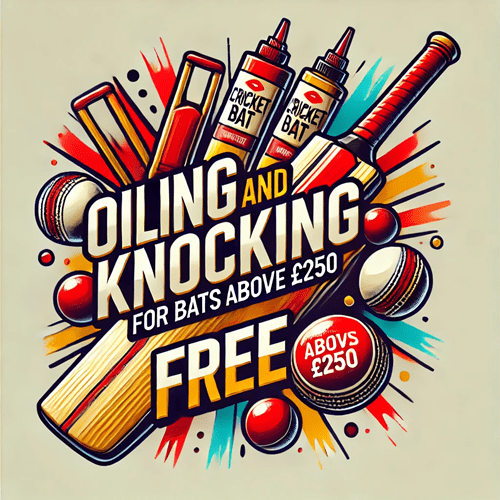Cricket Helmet Safety Standards: Complete Guide
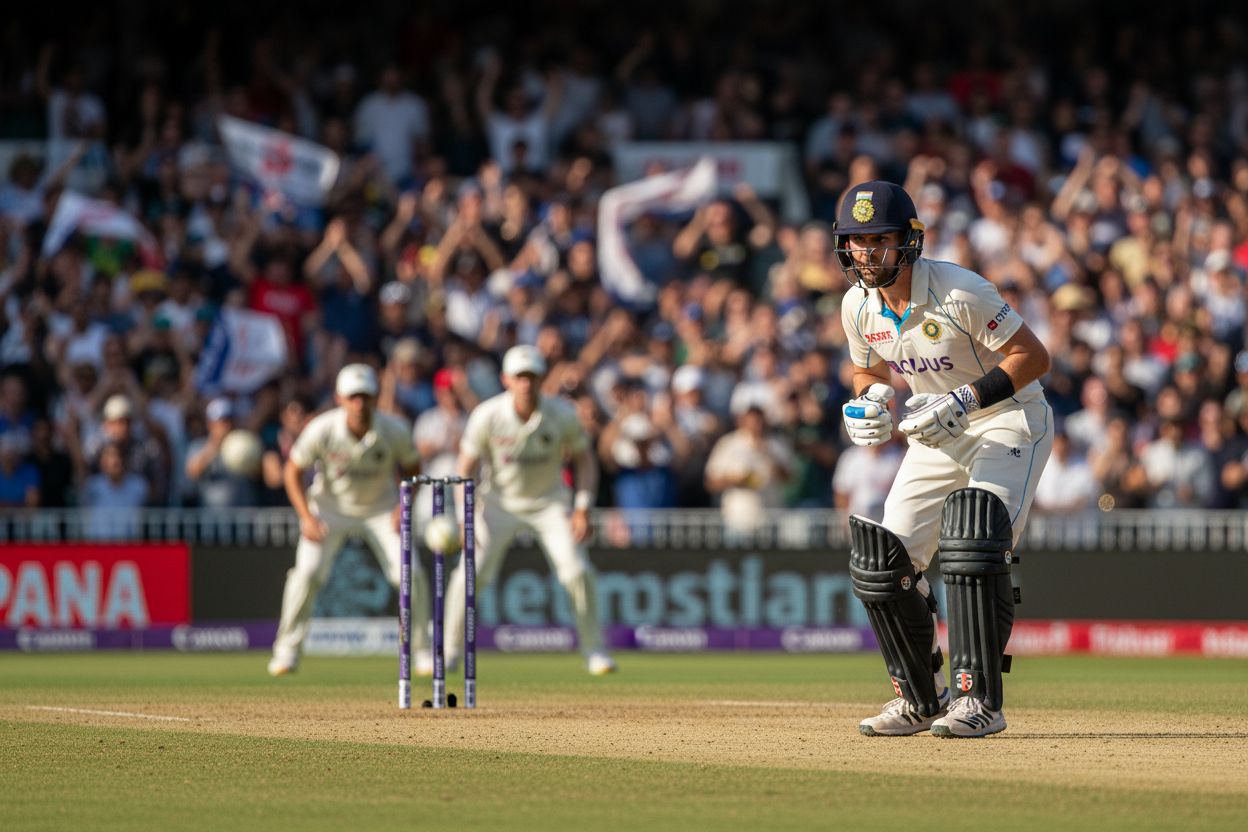
Every year, cricket balls strike players’ heads at speeds over 90 miles per hour, turning even a split-second lapse in helmet safety into a potentially life-changing event. With growing awareness of these risks, the rules surrounding cricket helmets have become a priority for leagues and parents alike. This guide reveals how modern safety standards and certifications are now shaping the equipment trusted by professionals and young players, offering peace of mind along with robust protection.
Key Takeaways
| Point | Details |
|---|---|
| Safety Standards | Cricket helmets must adhere to specific safety standards, particularly BS7928:2013, to ensure reliable protection against head injuries. |
| Certification Importance | Players should only use certified helmets to minimize risks, as non-compliant helmets increase the danger of severe injuries. |
| Maintenance Practices | Regular inspection and timely replacement of helmets are essential to maintain safety and structural integrity. |
| Regulatory Compliance | Compliance with international and local regulations is critical; non-compliance can lead to player suspension and serious repercussions. |
Table of Contents
- What Are Cricket Helmet Safety Standards?
- Types of Safety Certifications Worldwide
- Core Features of a Certified Cricket Helmet
- UK and International Regulatory Requirements
- Risks of Non-Compliant Helmets and Common Mistakes
- Care, Replacement, and Buying Best Practices
What Are Cricket Helmet Safety Standards?
Cricket helmet safety standards are comprehensive technical specifications designed to protect players from potential head and facial injuries during play. Safety standards ensure that helmets provide reliable protection against high-velocity cricket ball impacts, which can cause serious harm.
According to research from Loughborough University’s Sports Technology Research Group, the development of BS7928:2013 and its 2019 addendum has dramatically improved player protection. These standards have been instrumental in eliminating serious facial injuries across 104 countries, representing a significant leap forward in cricket equipment safety.
Key requirements in modern cricket helmet safety standards typically include:
- Impact resistance testing
- Penetration prevention mechanisms
- Comprehensive head and facial coverage
- Strict material durability guidelines
Research from the ICC’s Helmet Safety Project highlighted critical design improvements, such as addressing gaps between faceguards and visors and ensuring adequate rear-head protection. These standards aren’t just theoretical – they represent crucial engineering solutions that directly protect cricketers from potential life-altering injuries.
Types of Safety Certifications Worldwide
Cricket helmet safety certifications worldwide have evolved significantly, reflecting the ongoing commitment to player protection across different regions and competitive levels. Safety standards vary between countries, with some emerging as global benchmarks for equipment reliability and player safety.
Before the current international standards, two primary certification systems dominated the landscape. According to ICC research, prior to 2017, the cricket world relied on the British Standard BS7928 (1998) and the Australian Standard AS4499 (1997). These older standards primarily used drop-testing methods that did not comprehensively assess real-world facial impact scenarios.
Key international safety certifications include:
- British Standard BS7928:2013 (Most widely adopted)
- Australian Standard AS4499 (Regional standard)
- International Cricket Council (ICC) Regulations (Global enforcement)
From January 2017, the ICC made a groundbreaking move by mandating that all international cricket helmets must comply with the British Standard BS7928:2013. This regulation includes strict enforcement mechanisms: non-compliant helmets can result in warnings and potential player suspension, underscoring the serious commitment to player safety in modern cricket.
Here’s a summary of major cricket helmet safety certifications:
| Certification Standard | Region/Authority | Year Introduced | Key Features |
|---|---|---|---|
| BS7928:1998 | UK, Global prior to 2013 | 1998 | Drop-testing Limited facial protection |
| AS4499:1997 | Australia | 1997 | Regional standard Basic impact protection |
| BS7928:2013 | UK, ICC Mandated | 2013 | Advanced impact testing Comprehensive facial coverage |
| BS7928:2013+A1:2019 | UK, ICC Mandated | 2019 | Neck protection Improved impact attenuation |
| ICC Helmet Regulations | International | 2017 Mandatory | Compliance with BS7928:2013 Strict enforcement |
Core Features of a Certified Cricket Helmet
Certified cricket helmets are sophisticated pieces of protective equipment designed to meet rigorous safety standards that protect players from potentially life-threatening head and facial injuries. Impact protection stands as the primary function, with modern helmets engineered to absorb and distribute force from high-velocity cricket ball impacts.
According to ICC regulations, certified helmets must pass comprehensive testing protocols that simulate realistic ball impact scenarios. These standards require separate testing for men’s (5½ oz) and junior (4¾ oz) cricket balls, ensuring age-appropriate protection levels.
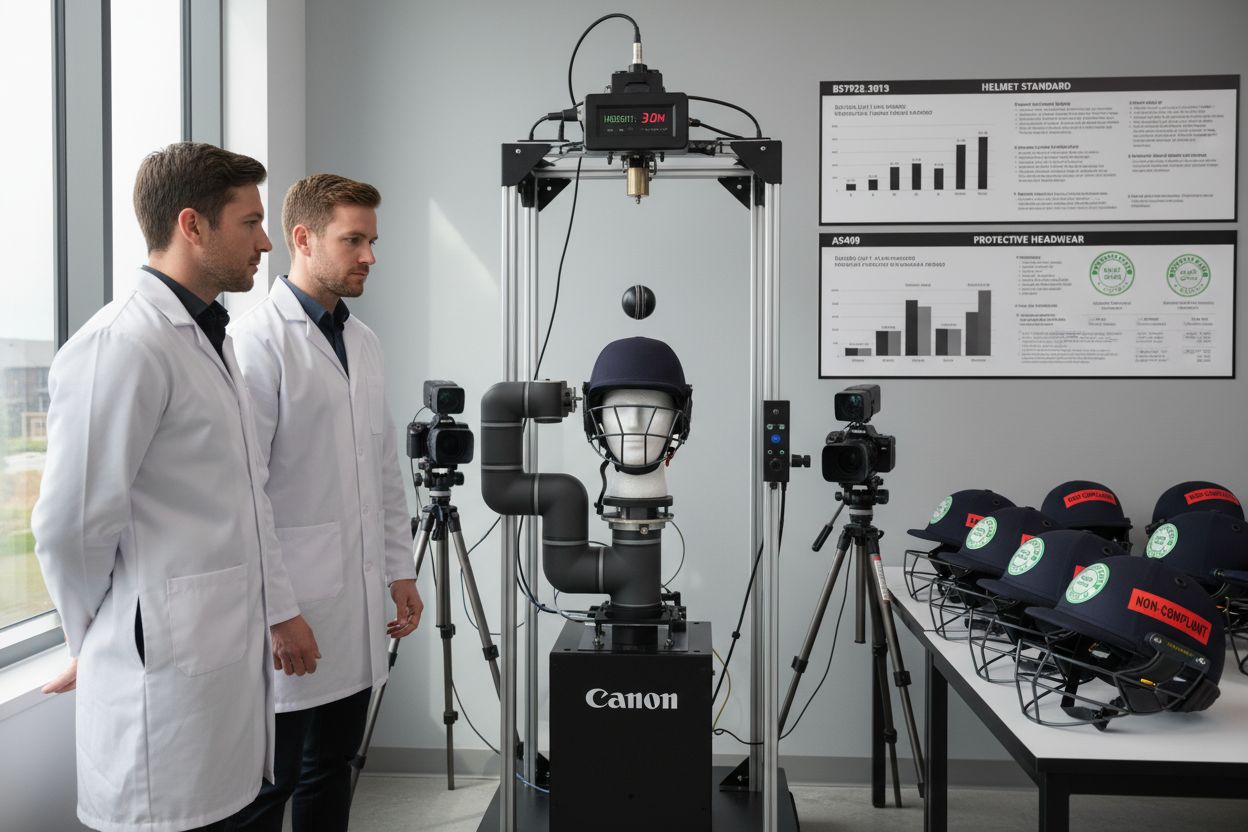 Check out our essential cricket equipment checklist to understand how helmets fit into comprehensive player safety gear.
Check out our essential cricket equipment checklist to understand how helmets fit into comprehensive player safety gear.
Key features of a certified cricket helmet include:
- Full cranial coverage
- Robust faceguard protection
- Shock-absorbing internal padding
- Secure and adjustable chin straps
- Lightweight materials for comfort and mobility
The updated BS7928:2013+A1:2019 standard introduces additional specifications for neck protectors, focusing on enhanced coverage and impact attenuation. These improvements specifically target reducing injuries at the base of the skull and upper neck area, demonstrating the ongoing evolution of cricket safety technology. Players can now rely on helmets that offer multilayered protection beyond traditional design constraints.
UK and International Regulatory Requirements
Cricket helmet regulations have become increasingly sophisticated, reflecting a growing commitment to player safety across international and national sporting bodies. Regulatory standards now provide comprehensive guidelines that ensure consistent protection for players at all levels of the game.
According to the International Cricket Council (ICC) Clothing and Equipment Regulations, players choosing to wear helmets in international cricket must use equipment compliant with BS7928:2013 or its latest addendum. These regulations mandate clear labeling for ball-size testing, covering both senior and junior categories, ensuring transparent and reliable protection standards.
Key regulatory requirements for cricket helmets include:
- Mandatory compliance with BS7928:2013 standard
- Specific testing for different ball weights
- Clear labeling of protective capabilities
- Age and category-specific protection guidelines
The England and Wales Cricket Board (ECB) has implemented equally rigorous standards for domestic cricket. They mandate helmet use for under-18 players during batting and recommend helmets tested for both men’s and junior ball sizes.
These regulations extend to women’s cricket, with specific recommendations for comprehensive head protection that addresses the unique requirements of different player categories.
Risks of Non-Compliant Helmets and Common Mistakes
Non-compliant helmets represent a significant risk to cricket players, potentially transforming what should be protective gear into a dangerous liability. Players who choose to use outdated or improperly tested helmets expose themselves to potentially life-altering head and facial injuries that could have been prevented by adhering to modern safety standards.
Common mistakes cricketers make with helmet selection include purchasing older models, ignoring certification labels, and using helmets that have been damaged or extensively worn. Explore the different types of cricket helmets to understand the nuanced safety features that distinguish compliant from non-compliant equipment. These errors can compromise critical protective elements like impact absorption, structural integrity, and comprehensive coverage.
Key risks associated with non-compliant helmets include:
- Inadequate impact protection
- Increased likelihood of skull fractures
- Compromised facial and neck protection
- Potential long-term neurological damage
- Higher risk of concussion
Beyond physical risks, using non-compliant helmets can lead to additional consequences. In professional and competitive cricket, players might face warnings, equipment disqualification, or even suspension from matches. The potential medical and professional repercussions far outweigh any perceived cost savings from using substandard equipment, making strict adherence to safety standards not just recommended, but absolutely essential for player safety.
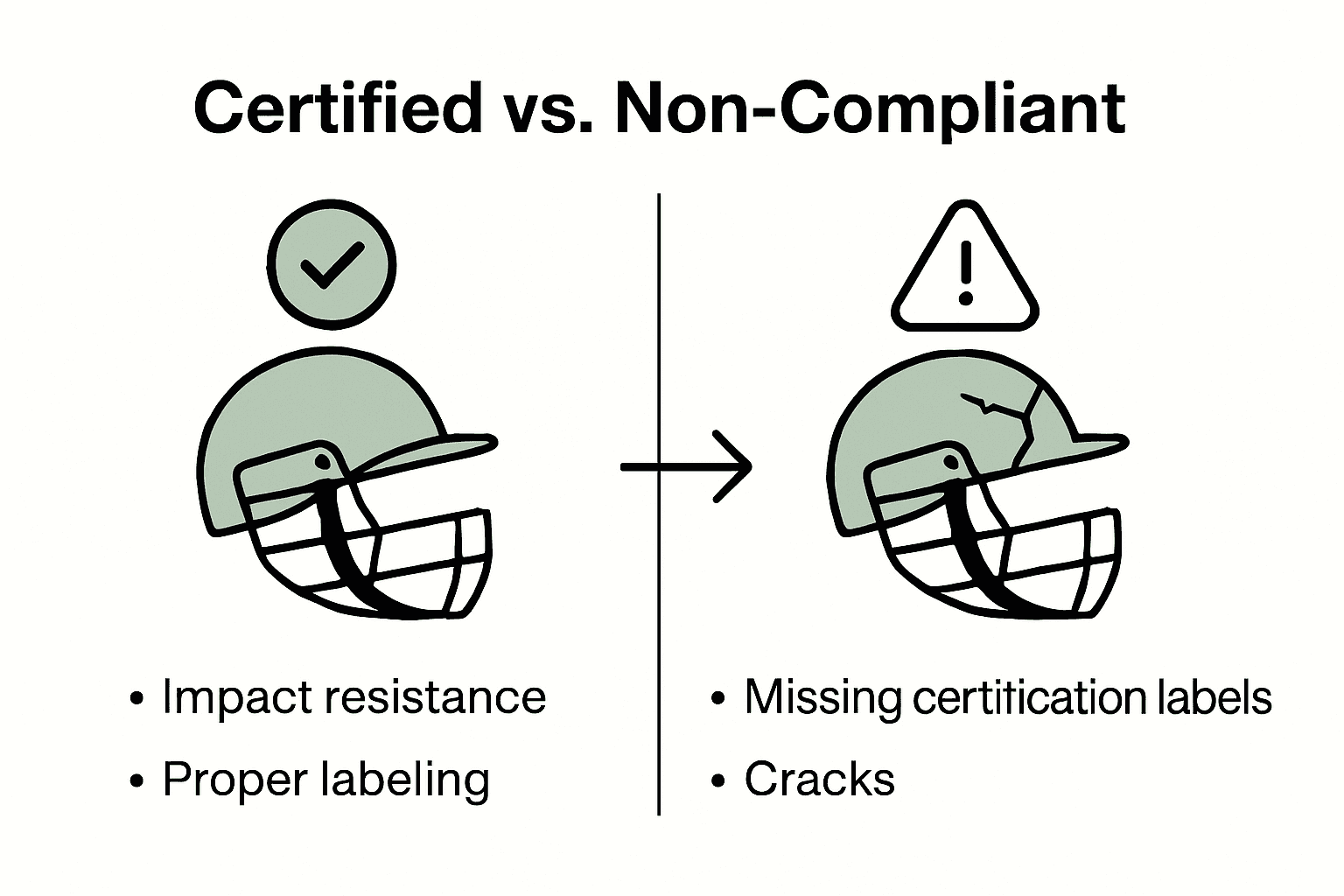
Care, Replacement, and Buying Best Practices
Maintaining the integrity of your cricket helmet is crucial for ensuring ongoing player safety and protection. Helmet maintenance goes beyond simple cleaning, involving careful inspection, proper storage, and understanding when replacement becomes necessary. Players must treat their protective gear as a critical investment in their personal safety.
According to ICC guidance, helmets can sustain structural damage even when no visible impact is apparent. The organization recommends replacing any helmet that has experienced a severe blow, as the protective integrity might be compromised without obvious external signs. Our comprehensive cricket equipment checklist can help you track and manage your protective gear effectively.
Key best practices for cricket helmet care include:
- Inspect for cracks, dents, or structural damage after each use
- Store in a cool, dry place away from direct sunlight
- Avoid dropping or impacting the helmet unnecessarily
- Clean with mild soap and water, avoiding harsh chemicals
- Replace padding if it becomes compressed or worn
Experts recommend replacing helmets every 3-5 years or immediately after any significant impact. When purchasing a new helmet, prioritize certification to BS7928:2013+A1:2019, ensuring a snug and comfortable fit that provides maximum protection without compromising mobility. Always invest in quality and never compromise on safety standards.
Protect Yourself with Certified Cricket Helmets from CricketKingdom.co.uk
Are you serious about keeping your head and face safe every time you step onto the cricket field? If helmet safety standards feel overwhelming or you worry that your current helmet doesn’t meet the latest BS7928:2013+A1:2019 certification, you’re not alone. Too many players risk severe injury by using non-compliant helmets and ignoring the latest safety standards. At CricketKingdom.co.uk, we understand how important reliable impact protection and true peace of mind are. Our guide has shown you how quickly unsafe equipment turns into a real threat, but you deserve equipment that stands up to every test and keeps you protected while playing your best.
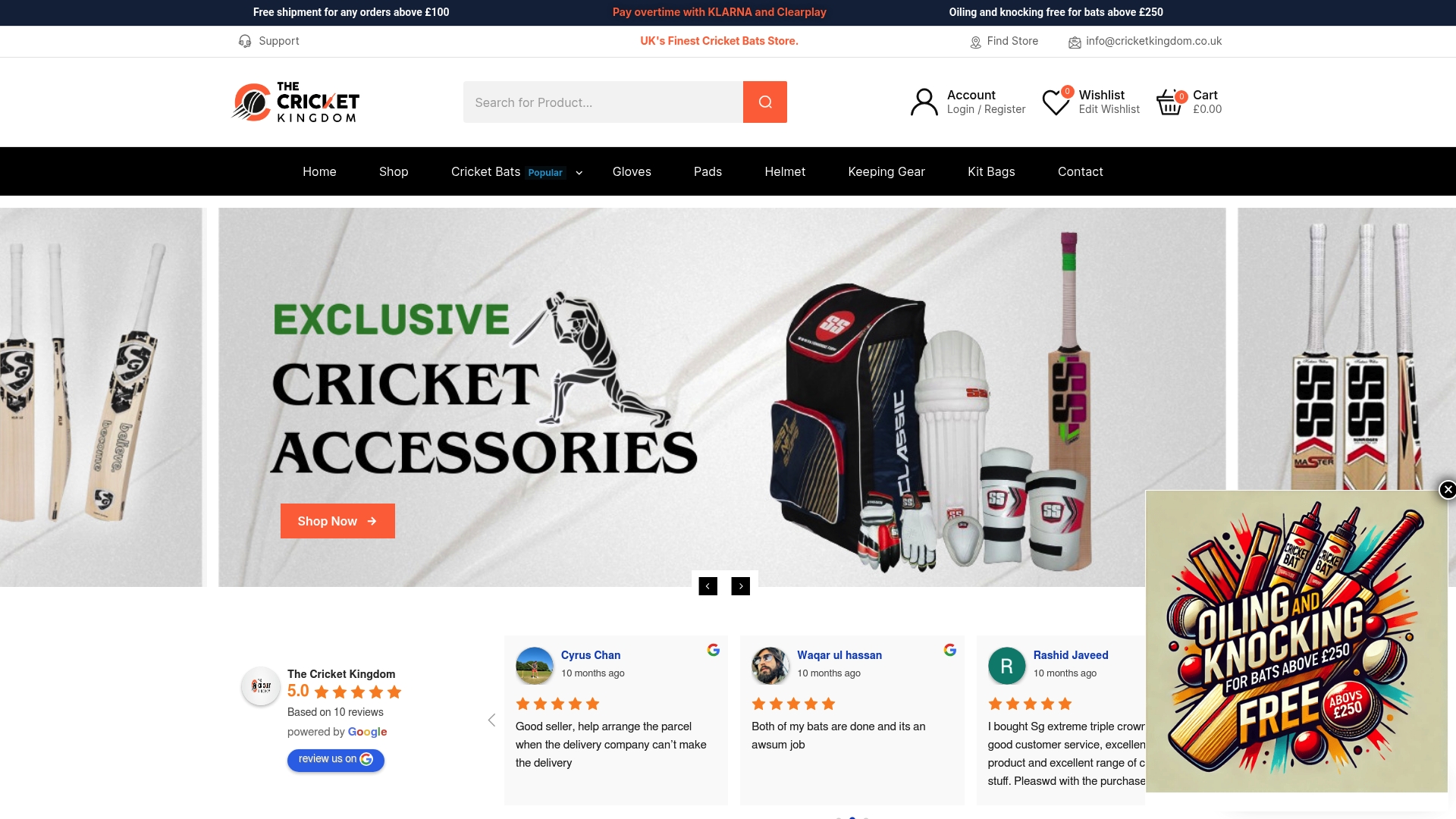
Take control of your safety today. Shop the latest certified helmets and essential gear at CricketKingdom.co.uk. For more on choosing the safest protective gear, visit our essential cricket equipment checklist or learn how different designs impact your protection on our types of cricket helmets page. Act now to secure your health, play with confidence, and enjoy fast shipping and top-rated support. Your safety is our top priority—make the switch to fully certified protection before your next match.
Frequently Asked Questions
What are the main safety standards for cricket helmets?
Cricket helmet safety standards include comprehensive specifications for impact resistance, penetration prevention, head and facial coverage, and material durability, primarily governed by BS7928:2013 and its subsequent addendums.
How often should cricket helmets be replaced to ensure safety?
It is recommended to replace cricket helmets every 3-5 years or immediately after a significant impact that may compromise the helmet’s protective integrity.
What are the key features of a certified cricket helmet?
Certified cricket helmets feature full cranial coverage, robust faceguard protection, shock-absorbing padding, adjustable chin straps, and lightweight materials. The updated standards also include specifications for neck protectors.
What are the risks associated with using non-compliant cricket helmets?
Using non-compliant helmets can lead to inadequate impact protection, increased risk of injuries like skull fractures and concussions, and potential long-term neurological damage, potentially jeopardizing player safety.
Recommended
- Understanding Types of Cricket Helmets for Safety – The Cricket Kingdom
- Understanding Cricket Gear Buying Guide for Players – The Cricket Kingdom
- 9 Essential Items for Your Cricket Equipment Checklist – The Cricket Kingdom
- Essential Cricket Equipment in the UK: Must-Have Gear for Every Cricketer – The Cricket Kingdom

